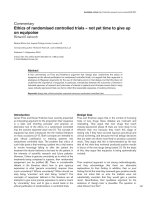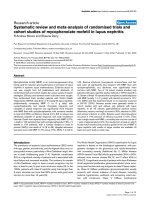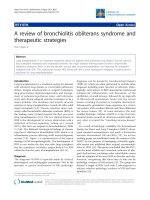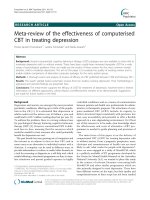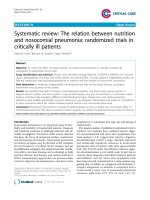Bóa cáo y học: "Ethics review: Perioperative do-not-resuscitate orders – doing ‘nothing’ when ‘something’ can be done" pptx
Bạn đang xem bản rút gọn của tài liệu. Xem và tải ngay bản đầy đủ của tài liệu tại đây (44.92 KB, 4 trang )
Page 1 of 4
(page number not for citation purposes)
Available online />Abstract
Cardiopulmonary resuscitation (CPR) has the ability to reverse
premature death. It can also prolong terminal illness, increase
discomfort and consume enormous resources. Despite the desire
to respect patient autonomy, there are many reasons why with-
holding CPR may be complicated in the perioperative setting. This
review outlines these factors in order to offer practical suggestions
and to provoke discussion among perioperative care providers.
Although originally described for witnessed intraoperative arrests,
closed chest cardiac massage quickly became universal practice,
and a legal imperative in many hospitals. Concerns were raised by
both health care workers and patient groups; this eventually led to
the creation of the do-not-resuscitate (DNR) order. However, legal
precedents and ethical interpretations dictated that patients were
expected to receive full resuscitation unless there was explicit
documentation to the contrary. In short, CPR became the only
medical intervention that required an order to prevent it from being
performed. Before the 1990s, patients routinely had pre-existing
DNR orders suspended during the perioperative period. Several
articles criticized this widespread practice, and the policy of
‘required reconsideration’ was proposed. Despite this, many
practical issues have hindered widespread observance of DNR
orders for surgical patients, including concerns related to the DNR
order itself and difficulties related to the nature of the operating
room environment. This review outlines the origins of the DNR
order, and how it currently affects the patient presenting for
surgery with a pre-existing DNR order. There are many obstacles
yet to overcome, but several practical strategies exist to aid health
care workers and patients alike.
Introduction
For health care professionals, whether doctor or nurse (and
regardless of specialty), there are few things harder than not
intervening when a patient suffers a cardiac arrest. In the
perioperative setting, anaesthesiologists and surgeons often
feel compelled to do everything possible. Reasons cited
include a desire to save the patient, the extensive
resuscitation training they possess, the resources invested in
the planned surgery, concerns that the surgical insult or
anaesthetic administration may have precipitated the cardio-
vascular collapse, and even pressure to keep the operating
room (OR) slate on track [1,2]. It is therefore little wonder that
perioperative care providers may have substantial difficulty
with do-not-resuscitate (DNR) orders. However, as many as
15% of patients with DNR orders will undergo surgery,
whether provoked by their underlying terminal disease or for
unrelated reasons [2]. Surgery often occurs to offer additional
time, comfort, or quality of life. Examples include repair of
pathological fractures, insertion of tracheostomy or gastros-
tomy tubes, bowel resections for obstruction, or vascular
access surgery. Therefore, this topic is relevant to all those
who are involved in their care.
This review considers the origins of the DNR order as it
relates to anaesthesia and critical care practice. We examine
the state of current opinion regarding the treatment of
patients presenting for surgery with pre-existing DNR orders.
As will become evident, whether closed chest cardiac
massage or electrical countershock is performed constitutes
only a small part of the necessary dialogue.
The history of cardiopulmonary resuscitation
Originally described in 1960 for witnessed intraoperative
arrests [3], closed chest cardiac massage was subsequently
applied to any patient experiencing cardiopulmonary arrest
[4]. In short, dying in hospital meant having had CPR
attempted. Poor survival statistics reflected its indiscriminate
application. Furthermore, ‘resistance’ grew but was often
secretive. The literature suggests that where resuscitation
was believed to be futile or nonbeneficial, hospital staff
conducted sham resuscitation attempts (‘slow codes’) or did
not activate the ‘code team’ at all. Some institutions even
developed secretive means of identifying those who would
not qualify for a full resuscitative effort [4,5]. Concerns were
raised regarding inadequate documentation, physician
Review
Ethics review: Perioperative do-not-resuscitate orders – doing
‘nothing’ when ‘something’ can be done
Mark Ewanchuk
1,2
and Peter G Brindley
2
1
Department of Anesthesiology and Pain Medicine, University of Alberta, Edmonton, Alberta, Canada
2
Division of Critical Care Medicine, University of Alberta, Edmonton, Alberta, Canada
Corresponding author: Peter Brindley,
Published: 3 July 2006 Critical Care 2006, 10:219 (doi:10.1186/cc4929)
This article is online at />© 2006 BioMed Central Ltd
CPR = cardiopulmonary resuscitation; DNR = do-not-resuscitate; OR = operating room.
Page 2 of 4
(page number not for citation purposes)
Critical Care Vol 10 No 4 Ewanchuk and Peter G Brindley
accountability, and the fact that patients and their families
were often excluded from the decision making process.
Accusations of paternalism and covert decision making were
made, and concerns were raised regarding an erosion of trust
between health care workers and the public [4].
It was not until the mid-1970s that decisions not to
resuscitate were first legalized. In the USA the American
Medical Association first recommended that decisions to
forego resuscitation be formally documented and
communicated [6]. Furthermore, it was emphasized that CPR
was intended for the prevention of a sudden, unexpected
death – not the treatment of a terminal, irreversible illness [6].
Explicit DNR policies soon followed, and patients’ right to
self-determination was promoted. At the root of the debate, it
was categorically assumed that the patient would always
prefer resuscitation, and that anything to the contrary
required their explicit consent. Critics have questioned such
an approach and have argued that CPR was never intended
(nor is it efficacious) in all situations [4]. Therefore, CPR
should only be offered to those for whom it is medically
indicated. However, the 1983 report of the President’s
Commission for the Study of Ethical Problems in Medicine
disagreed; a resuscitation attempt was favoured in nearly all
instances, and patients were presumed to have given implicit
consent for CPR [4]. As such, CPR became the standard of
care, and all patients were ‘full code’ unless clearly
documented otherwise. CPR became the only medical
therapy that required a physician’s order for it to be withheld,
hence the DNR order [7]. DNR orders have subsequently
taken some time to gain widespread acceptance in all
hospital environments. As is outlined below, the OR was one
such environment [1].
The situation prior to the 1990s
Before the 1990s, formal policies to accommodate the peri-
operative patient with a DNR order were rare. Consequently,
decisions were typically left to the attending surgeon and/or
anaesthesiologist, and DNR orders were routinely sus-
pended during the intraoperative and immediate post-
operative periods [8,9]. In 1991, several articles criticized
this widespread practice [5,8,9]. In effect, concerns were
raised that patients were forced to compromise their
autonomy and right to self-determination in order to qualify
for surgery. This led to a policy of ‘required reconsideration’,
and three distinct courses of action were identified. The
American Society of Anesthesiologists formalized this policy
in a set of guidelines approved in 1993 and updated in 1998
[10].
The policy of required reconsideration
Following discussions with the patient or his/her surrogate,
the DNR order could be formally rescinded with the patient’s
informed consent; it could be left in place, specifying an
outline of the patient’s goals and objectives; or it could be left
in place, detailing an exhaustive list of the procedures and
interventions that the patient would permit. A detailed
discussion of these approaches may be obtained in the
articles by Waisel and Truog [1,7]. However, what must be
emphasized is that, although the policy of required
reconsideration is well founded, its application necessitates
closer examination of the OR environment.
Challenges of adhering to an intraoperative
do-not-resuscitate order
The reasons for reluctance to adhere to a pre-existing DNR
order during the perioperative period may be divided into two
main categories: concerns regarding the DNR order itself and
difficulties related to the nature of the OR environment.
With regard to the DNR order, anaesthesiologists may be
appropriately sceptical of what they read in the patient’s
chart; after all, up until that time, they probably know little
about the patient. In addition, the surgeon may not be the
patient’s primary physician. Although this argues strongly for
the need to visit such patients preoperatively, it should be
appreciated that anaesthesiologists are accustomed to
adjusting preoperative orders in order to optimize patients for
surgery. Furthermore, the rationale for and events leading up
to the writing of the DNR order will be questioned. When was
the order last updated? Why was it written? With whom was
it discussed? By whom was it written? Was accurate
prognostic information provided to the patient? Did the
patient actually possess an illness commonly regarded as
terminal? To what extent did the clinician influence the
eventual decision? This final question is especially pertinent,
given the disparity in opinions among physicians regarding
the prognosis of various conditions [4,11]. In this regard,
surgeons and anaesthesiologists are no different from any
other physician taking over the care of a new patient; they will
err on the side of treating aggressively unless certain that
they should do otherwise. Moreover, there are significant
discrepancies between physician estimates of and patient
self-reporting regarding resuscitation preferences [12].
Advanced directives are also problematic; they are often out
of date, and either overly restrictive (i.e. ‘no life support’) or
vague (‘treat me aggressively unless my disease is
irreversible’) so as to make specific decision making difficult.
It is impossible for advanced directives to address adequately
the myriad of clinical situations that may be encountered in
the operative setting. This includes not only chest
compressions or electrical countershock, but also what
would constitute excessive vasopressor dosing or an in-
appropriate duration for resuscitation. Add to this a non-
communicative patient, the absence of a surrogate decision
maker to provide verification, and evidence suggesting poor
patient–surrogate congruence [13,14] and the physician may
be placed in a very difficult position. Legally, where
documentation is unclear (or the physician is unable to
authenticate it), US statutes have dictated that life-sustaining
treatment must be continued [4]. Practically, it is hardly
surprising that OR staff tend to favour aggressive intervention.
Page 3 of 4
(page number not for citation purposes)
The second factor that hinders intraoperative observance of
the DNR order is the nature of the OR environment itself.
Many consider intraoperative maintenance of cardiorespiratory
stability central to the function of an anaesthesiologist. Rather
than constituting extraordinary intervention, ‘resuscitation’ is
what the anaesthesiologist does, and why he or she is
present! Although vasopressor administration may represent
unusual treatment outside the OR, it is commonplace in a
surgical suite. Many may draw the line at chest compressions
or electrical countershock, but it is easy to see how the
boundaries may become blurred. To some, the very fact that
an individual is ‘approved’ for surgery implies that he or she is
expected to survive. In addition, all intraoperative arrests
should be witnessed, and therefore survival rates should be
higher [15]. As a result it can be argued that these arrests
differ greatly from the typical unwitnessed arrest, and
therefore so should the philosophy of care. For all of these
reasons, asking a surgeon or anaesthesiologist not to
intervene is asking for a fundamental change in mindset.
Death in the operating room
What is rarely highlighted are the everyday stressors placed
upon those in the OR setting. Should a patient deteriorate,
there is typically no time for family discussion, let alone
consultation with other health care providers (including, for
example, clinical ethicists). Should the patient ultimately die,
then the OR may be out of service for hours. Many other
procedures may be subsequently postponed or cancelled. All
in all, the OR is a poor environment for end-of-life care; there
is no provision for family visitation, or administration of
religious rites, or lengthy debriefing of the OR staff. It may
seem aggravating to critical care staff to assume the care of a
post-arrest patient rushed from the OR, especially with very
little chance of survival. However, it requires a pragmatic
understanding of the alternative – a death in the intensive
care unit may at least offer respite to the family and dignity to
the patient.
Philosophically, there may also be an important difference
between the perception of a ward death versus that of an OR
death. As one author put it [16], “when the patient of an
internist dies, the natural question his colleagues ask is, ‘what
happened?’ When the patient of a Surgeon dies, his
colleagues ask, ‘what did you do?’” Surgical acts of commis-
sion (versus medical acts of omission) increase not only the
likelihood of feelings of guilt, but they may also have legal
ramifications. In order to combat this phenomenon, such
deaths should be classified as ‘expected’ (versus
‘unexpected’), and any subsequent morbidity and mortality
review should examine the appropriateness of the patient’s
refusal of aggressive treatment, whether documentation was
adequate, and whether care was consistent with the patient’s
expressed wishes [5]. Just because a patient dies does not
mean that blame must automatically be apportioned.
Unfortunately, institutional policies have been slow to reflect
this [2,17].
Practical strategies
It is important that all such patients be seen by the
anaesthesiologist and/or surgeon preoperatively. Pre-emptive
multidisciplinary discussion is recommended and should
include the patient and/or patient’s representative surrogate,
the anaesthesiologist, the surgeon, and the intensivist who
may be called upon postoperatively [7]. Multidisciplinary
discussions allow time to address the complex ethical and
practical issues. If the DNR order is subsequently rescinded
(as is often the case), then the time period and circumstances
under which it is to be re-enacted should be specified [5].
Patient preferences for specific interventions such as chest
compressions and electrical countershock should be
explored. Such frank and open discussions promote a sense
of trust between the patient, the physician and the health care
team at large. Furthermore, ‘autonomous medical choices are
usually enhanced rather than undermined by the input and
support of a well-informed physician’ [18]. Consideration
should be given to early ethics consultation [19], and
documentation should always be rigorous. The specifics
should ultimately be reviewed with the entire OR team to
ensure that everyone understands the underlying philosophy
of care. In nonemergent circumstances, dissenting staff may
ethically decline to participate, providing that alternative
providers may be found [5]. In the case of a patient with an
illness not commonly regarded as terminal, securing staff
compliance may be even more difficult. However, given
competent and informed refusal of care, patient autonomy
must be respected. A patient should not be refused
appropriate operative management simply because the
surgical team is uncomfortable with their wish not to receive
full CPR. Of note, this is why many patients are hesitant to
establish DNR orders in the first place; patients and their
families often feel that they will be regarded and treated
differently [12]. Perhaps Prendergast and Puntillo [20] put it
best: ‘A major goal in conversations with patients is to
reassure them that they will be treated as aggressively as is
consistent with their wishes, but that their physicians’ goal is
to understand those wishes should curative efforts fail.’
Conclusion
CPR has the potential to reverse premature death. Sadly, it
also has the potential to prolong inevitable death, to cause
discomfort, to increase emotional distress and to consume
enormous resources. Despite the ardent desire to sustain life,
medical professionals can withstand the temptation to
intervene when they are faced with the patient who wishes
not to be resuscitated. Rather than perceiving that they are
doing nothing, something has indeed been done; the wishes
of the patient have been respected, their autonomy has been
preserved and they have been allowed to die with dignity.
Complying with these wishes represents one of the greatest
challenges that we as physicians must face.
Competing interests
The authors declare that they have no competing interests.
Available online />References
1. Truog RD, Waisel DB: Do-not-resuscitate orders: from the
ward to the operating room; from procedures to goals. Int
Anesthesiol Clin 2001, 39:53-65.
2. Margolis JO, McGrath BJ, Kussin PS, Schwinn DA: Do not resus-
citate (DNR) orders during surgery: ethical foundations for
institutional policies in the United States. Anesth Analg 1995,
80:806-809.
3. Kouwenhoven WB, Jude JR, Knickerbocker GG: Closed-chest
cardiac massage. JAMA 1960, 173:1064-1067.
4. Burns JP, Edwards J, Johnson J, Cassemm NH, Truog RD: Do-
not-resuscitate order after 25 years. Crit Care Med 2003, 31:
1543-1550.
5. Walker RM: DNR in the OR: resuscitation as an operative risk.
JAMA 1991, 266:2407-2412.
6. American Heart Association: Standards and guidelines for car-
diopulmonary resuscitation (CPR) and emergency cardiac
care (ECC): medicolegal considerations and recommenda-
tions. JAMA 1974, 227(suppl):864-866.
7. Waisel DB, Truog RD: The end-of-life sequence. Anesthesiol-
ogy 1997, 87:676-686.
8. Truog RD: ‘Do-not-resuscitate‘ orders during anesthesia and
surgery. Anesthesiology 1991, 74:606-608.
9. Cohen CB, Cohen PJ: Do-not-resuscitate orders in the operat-
ing room. N Engl J Med 1991, 325:1879-1882.
10. American Society of Anesthesiologists: Ethical Guidelines for the
Anesthesia Care of Patients with Do-not-resuscitate Orders or
Other Directives That Limit Care; 1999 Directory of Members.
Park Ridge, IL: American Society of Anesthesiologists; 1999:470-
471.
11. Wachter RM, Luce JM, Hearst N, Lo B: Decisions about resusci-
tation: inequities among patients with different diseases but
similar prognoses. Ann Intern Med 1989, 111:525-532.
12. Phillips RS, Wenger NS, Teno J, Oye RK, Youngner S, Califf R,
Layde P, Desbiens N, Connors AF Jr, Lynn J: Choices of seri-
ously ill patients about cardiopulmonary resuscitation: corre-
lates and outcomes. SUPPORT Investigators. Study to
Understand Prognoses and Preferences for Outcomes and
Risks of Treatments. Am J Med 1996, 100:128-137.
13. Lo B, Steinbrook R: Resuscitating advance directives. Arch
Intern Med 2004, 164:1501-1506.
14. Caruso LJ, Gabrielli A, Layon AJ: Perioperative do not resusci-
tate orders: caring for the dying in the operating room and the
intensive care unit. J Clin Anes 2002, 14:401-404.
15. Brindley PG, Markland DM, Mayers I, Kutsogiannis DJ: Predictors
of survival following in-hospital adult cardiopulmonary resus-
citation. CMAJ 2002, 167:343-348.
16. Bosk CL: Forgive and Remember: Managing Medical Failure.
Chicago, IL: University of Chicago Press; 1979:29-30.
17. Waisel DB, Burns JP, Johnson JA, Hardart GE, Truog RD: Guide-
lines for perioperative do-not-resuscitate policies. J Clin Anes
2002, 14:467-473.
18. Quill TE, Brody H: Physician recommendations and patient
autonomy: finding a balance between physician power and
patient choice. Ann Intern Med 1996, 125:763-769.
19. Waisel DB: Perioperative do-not-resuscitate orders. Curr Opin
Anaesthesiol 2000, 13:191-194.
20. Prendergast TJ, Puntillo KA: Withdrawal of life support: inten-
sive caring at the end of life. JAMA 2002, 288:2732-2740.
Critical Care Vol 10 No 4 Ewanchuk and Peter G Brindley
Page 4 of 4
(page number not for citation purposes)

